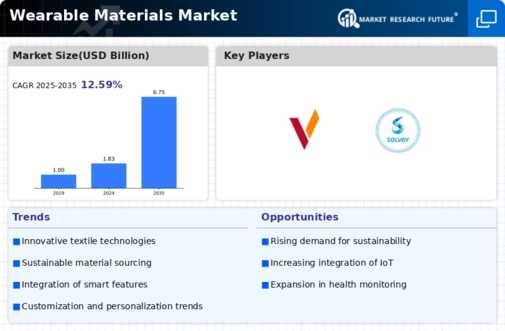Market Trends
Key Emerging Trends in the Wearable Materials Market
Wearable Materials are witnessing significant trends at present, which are reflective of shifts in demand and applications across various sectors of wearable technology. Wearable materials include advanced textiles, polymers, and components used in manufacturing smart clothing and wearable devices. One notable trend in this industry is the growing overlap between smart capabilities and everyday clothes. Additionally, the healthcare sector plays a vital role in shaping the wearable material markets. For instance, wearable medical devices like smart patches or continuous monitoring systems require flexible, durable materials that are biocompatible. Wearable technologies should provide comfort to patients who use them while ensuring their effectiveness; all these aspects have led to further advancement in remote patient monitoring principles, leading to personalized healthcare solutions. What's more important here is that this particular fashion trend revolves around preventive medicine/healthcare with reference to non-invasive diagnostic tools. Sustainable consumption patterns emerge as one of the key trends observed within the wearable inputs market today. Manufacturing firms increasingly opt for recyclable, eco-friendly options when producing electronic accessories/wearables, etc. Thus, manufacturers are adopting sustainable alternatives such as biobased polymers or recycled products aimed at reducing the overall environmental impact resulting from the consumption of wearable gadgets. Further, sports and fitness industries contribute to fashion within the wearables' market space; hence, athletes are taking up gear fitted with sensors that help monitor and track performance. Wearable materials in sports apparel are designed to enhance comfort, provide moisture-wicking properties, and accommodate sensors that track metrics such as heart rate and body temperature. This move has been driven by the need to have facts on board concerning athletic achievements as well as personal wellness. Collaboration and partnership among wearable materials companies are increasing. Companies collaborate to conduct joint research on new uses and the development of novel formulations of wearable technology materials. Furthermore, wearables market trends are affected by technological advancements. In an ongoing process, researchers are working towards improving the properties such as stretchability, conductivity, and washability of these wearable materials while manufacturers continue to improve them. This includes flexible electronics, conductive textiles, and advanced polymers that can be used under regular wearing conditions without any damage done to them or change in their appearance over time, among others. Stretchable devices also form part of innovations in this sector, which makes them adaptable and effective for solutions in the wearables area amid its ever-changing environment regarding technology.






Leave a Comment